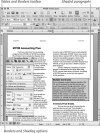- Character Formatting
- Paragraph Formatting
- Using Word Styles
Paragraph Formatting
Some formatting is paragraph-specific. That is, rather than affecting individual words or sentences, it affects the entire paragraph. Common paragraph formatting that you can apply includes alignment, indents, tab stops, and line spacing. You can also create bulleted or numbered lists, and add borders or shading.
Setting paragraph alignment
Each paragraph in a document can be aligned left, center, right, or justified (Figure 4.6), as explained below:
- Left is the most common alignment setting and is the default. Text in a left-aligned paragraph is flush with the left margin and ragged on the right margin.
- Center-aligned paragraphs are horizontally centered between the left and right margins and are ragged on both sides. Center alignment is sometimes used for titles and section heads.
- Right-aligned paragraphs are flush with the right margin and ragged on the left.
- Justified paragraphs are aligned flush with both the left and right margins. You'll often see this in newspapers and magazines. The spacing between words is automatically adjusted as needed to maintain the flush margins.

Figure 4.6 These paragraph alignments are available in Word.
To set alignment for a paragraph:
- Select one or more paragraphs whose alignment you want to change.
-
Do one of the following:
- Click an alignment icon on the Formatting toolbar (Figure 4.7).

Figure 4.7 One of the quickest ways to set alignment is to click an icon on the Formatting toolbar.
- Expand the Alignment and Spacing section of the Formatting Palette, and click an alignment icon (Figure 4.8).
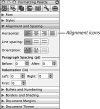
Figure 4.8 You can also click an alignment icon on the Formatting Palette.
- Choose Format > Paragraph. The Paragraph dialog box appears. On the Indents and Spacing tab, choose an alignment from the Alignment drop-down menu (Figure 4.9) and click OK.
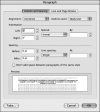
Figure 4.9 Although it's more convenient when you have multiple options to set, you can also set alignment in the Paragraph dialog box.
- Click an alignment icon on the Formatting toolbar (Figure 4.7).
The selected paragraph(s) are aligned as directed.
Indenting paragraphs
An indent is space between a paragraph and the left or right margin. Indents can be used to set off quotations from surrounding text (left and right indents), format body paragraphs in a business letter or school report (first line indents), and create bulleted or numbered lists (hanging indents).
Before setting an indent, you must first select the paragraph(s). Selecting a paragraph for formatting is different from selecting a word. You don't have to select the entire paragraph; it's sufficient to just click somewhere within it. To select multiple contiguous paragraphs, drag through them. To select multiple noncontiguous paragraphs, you can  -double click a word in each one.
-double click a word in each one.
You can set paragraph indents using the Formatting Palette, the Paragraph dialog box, or the ruler. You can create the following types of indents in Word:
- Left. Indents the paragraph from the left margin.
- Right. Indents the paragraph from the right margin.
- First. Indents only the first line of the paragraph.
- Hanging. Indents the entire paragraph except for the first line.
To indent paragraphs using the Formatting Palette:
- Select the paragraph(s).
- Expand the Alignment and Spacing section of the Formatting Palette.
- In the Indentation area, set the Left, Right, and/or First indent (Figure 4.10).
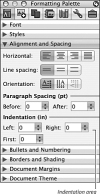
Figure 4.10 You can specify a left, right, or first line indent in the in the Alignment and Spacing section of the Formatting Palette.
To indent paragraphs using the Paragraph dialog box:
- Select the paragraph(s).
Choose Format > Paragraph or press
 .
.The Paragraph dialog box appears.
- Switch to the Indents and Spacing tab.
-
Do any of the following:
- In the Indentation section of the tab (Figure 4.11), change the values for Left and/or Right. The numbers correspond to the ruler that appears above the document text.

Figure 4.11 For greater precision in setting indents, use these options on the Indents and Spacing tab of the Paragraph dialog box.
- To set a first line or hanging indent, choose First line or Hanging from the Special drop-down menu and then enter a value in the By text box.
- In the Indentation section of the tab (Figure 4.11), change the values for Left and/or Right. The numbers correspond to the ruler that appears above the document text.
- Click OK to apply the new settings to the selected paragraph(s).
To indent paragraphs using the ruler:
- To create a uniform or flush indent, move the First Line Indent marker so it is directly above the Hanging and Left Indent markers (Figure 4.12). Then click and drag the square base of the Left Indent marker. The three markers will move together.
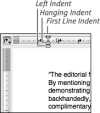
Figure 4.12 Align these three indent markers to create a block (to format a quotation, for example).
- To set a first line indent, move the First Line Indent marker (Figure 4.13). Note that it moves independently of the other indent markers.

Figure 4.13 Move the First Line Indent marker slightly to the right to create a paragraph style that is commonly used in business and education documents.
- To create a hanging indent, move the First Line Indent marker to the left of the Left Indent marker and move the Hanging Indent marker to the position where the indent will begin.
- To set the indent for the right side of a paragraph, move the Right Indent marker.
Setting line spacing
Being able to modify line spacing is especially useful if you're creating a document that has space restrictions or when it must follow line-spacing requirements set by an editor or teacher. The most common line spacings are single, 1.5, and double. You can also specify an exact value.
To set line spacing for a paragraph:
- Select the paragraph or paragraphs for which you want to set line spacing.
-
Do either of the following:
- In the Formatting Palette, expand the Alignment and Spacing section, and then click one of the Line spacing icons (see Figure 4.10).
- Choose Format > Paragraph or press
 . The Paragraph dialog box appears. On the Indents and Spacing tab, choose a line spacing option from the Line spacing drop-down menu (Figure 4.16) and click OK.
. The Paragraph dialog box appears. On the Indents and Spacing tab, choose a line spacing option from the Line spacing drop-down menu (Figure 4.16) and click OK.
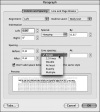
Figure 4.16 For precise line spacing needs, you can choose a setting from the Line spacing drop-down menu in the Paragraph dialog box.
Setting tab stops
Tab stops are often used to align text and numbers in neat columns. For example, you can use tabs to create tables in which the entries are aligned on their left edges, right edges, or decimal points (Figure 4.17).

Figure 4.17 By judiciously choosing and setting tab stops, you can create perfectly aligned tables.
To set tabs:
- Select the paragraph(s) for which you want to set tab stops.
-
Click the tab alignment icon to the left of the ruler, and choose the type of tab you want to set (Figure 4.18).

Figure 4.18 Choose a tab style from this pop-up menu.
Click the ruler at the location where you want to place the tab stop.
If the placement is off, you can drag the marker to another spot on the ruler.
- To add more tab stops for the selected paragraph(s), repeat Steps 2 and 3.
- If the selected paragraphs don't already contain tabs, insert them as necessary by pressing
 . Affected text will conform to the new tab stops.
. Affected text will conform to the new tab stops.
Bulleted and numbered lists
Bullets help break text into readable chunks, making it simpler for a reader to find and digest important points. Word also lets you generate numbered lists, such as points in a contract. The procedures for adding bullets and numbers are very similar. You can apply bullets and numbering to paragraphs before or after you've typed the text.
To create bulleted or numbered lists:
-
Do either of the following:
- To use the default bullet or numbering style for selected paragraphs, click an icon in the Bullets and Numbering section of the Formatting Palette (Figure 4.20) or the same icon on the Formatting toolbar.

Figure 4.20 Click an icon to enable/disable bullets or numbers for selected paragraph(s).
- Choose Format > Bullets and Numbering. On the Bulleted (Figure 4.21) or Numbered tab of the Bullets and Numbering dialog box, select a bullet or numbering style and click OK.

Figure 4.21 Select one of these bullet styles. To use a different character or otherwise alter the bullet settings, click the Customize button.
- To use the default bullet or numbering style for selected paragraphs, click an icon in the Bullets and Numbering section of the Formatting Palette (Figure 4.20) or the same icon on the Formatting toolbar.
The paragraph series becomes a bulleted or numbered list.
Applying borders and shading
Borders and shading can add style to a document or serve to highlight an important paragraph. You can set a border around selected pages, paragraphs, or text. You can do the same with shading.
To apply a border or shading:
- Select the text to which you'd like to add a border or shading.
Choose Format > Borders and Shading.
The Borders and Shading dialog box appears (Figure 4.23).

Figure 4.23 Add a border or shading to selected text in the Borders and Shading dialog box.
-
Do either of the following:
- To add a border around selected text or selected paragraphs, click the Borders tab.
- To add a border around one or more pages, click the Page Border tab.
- Select a border type: None, Box, Shadow, 3-D, or Custom.
- Optional: If you don't like the default settings, you can specify a different line style, color, and/or width for the border.
-
Optional: To adjust the offset that separates the border from the text on each side, click the Options button (Figure 4.24).
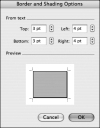
Figure 4.24 You can change the offset between each border edge and the text.
- On the Shading tab (Figure 4.25), select a shading color in the Fill section and a shading pattern in the Patterns section.

Figure 4.25 Select a shading color and pattern on the Shading tab.
- From the Apply to drop-down menu, choose the part of the document to which you want to apply the border and/or shading. Click OK.
 to end a paragraph, the next paragraph automatically takes on the alignment of the paragraph you just completed.
to end a paragraph, the next paragraph automatically takes on the alignment of the paragraph you just completed.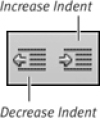

 ) prior to setting the line spacing.
) prior to setting the line spacing.

